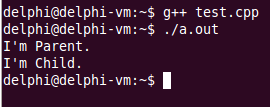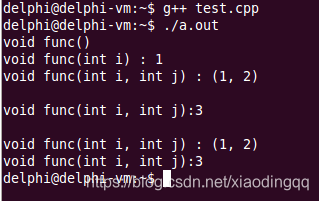C++深度解析 多型的概念和意義 --- virtual,虛擬函式,靜態聯編,動態聯編
阿新 • • 發佈:2019-01-07
C++深度解析 多型的概念和意義 --- virtual,虛擬函式,靜態聯編,動態聯編
多型
通過使用virtual關鍵字對多型進行支援
示例程式:
#include <iostream> #include <string> using namespace std; class Parent { public: //print()函式被繼承會被重寫,多型的行為 virtual void print() { cout << "I'm Parent." << endl; } }; class Child : public Parent { public: //虛擬函式 void print() { cout << "I'm Child." << endl; } }; void how_to_print(Parent* p) { p->print(); //展現多型的行為 } int main() { Parent p; Child c; how_to_print(&p); // Expected to print:I'm Parent how_to_print(&c); // Expected to print:I'm Child return 0; }
結果如下:

多型的意義:
在程式執行過程中展現出動態的特性
函式重寫必須多型實現,否則沒有意義
多型是面向物件元件化程式設計的基礎特性
靜態聯編:
在程式的編譯期間就能確定具體的函式呼叫,如:函式過載
動態聯編:
在程式實際執行後才能確定具體的函式呼叫,如:函式重寫
示例程式:
#include <iostream> #include <string> using namespace std; class Parent { public: //虛擬函式 virtual void func() { cout << "void func()" << endl; } //虛擬函式 virtual void func(int i) { cout << "void func(int i) : " << i << endl; } //虛擬函式 virtual void func(int i, int j) { cout << "void func(int i, int j) : " << "(" << i << ", " << j << ")" << endl; } }; class Child : public Parent { public: //重寫父類的函式,虛擬函式 void func(int i, int j) { cout << "void func(int i, int j):" << i + j << endl; } //在Child類裡面的兩個func()函式,是函式過載 void func(int i, int j, int k) { cout << "void func(int i, int j, int k):" << i + j + k << endl; } }; //全域性函式 void run(Parent* p) { //同一行語句展現出不同的呼叫結果 p->func(1, 2); //展現多臺的特性 //動態聯編 } int main() { Parent p; p.func(); //靜態聯編 p.func(1); //靜態聯編 p.func(1, 2); //靜態聯編 cout << endl; Child c; c.func(1, 2); //靜態聯編 cout << endl; run(&p); //動態聯編 run(&c); //動態聯編 return 0; }
結果如下:

